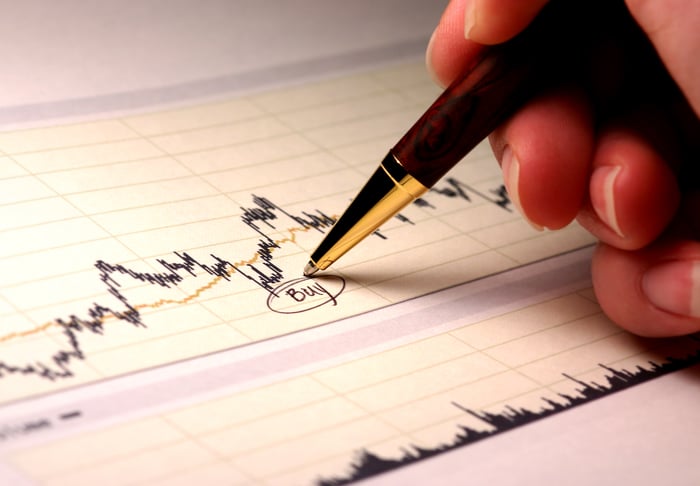Wall Street and investors have been taken for quite the ride over the past two months. In that span, uncertainties tied to the coronavirus disease 2019 (COVID-19) wound up pushing equities into their fastest bear market in history, with the benchmark S&P 500 losing a whopping 34% of its value in a mere 33 calendar days.
We also witnessed record-breaking volatility, with the CBOE Volatility Index registering its highest reading ever, and the S&P 500 logging its eight-largest single-day point gains, as well as 10 of its 13-biggest single-session point declines, in history.
While predicting short-term movements in the stock market is more luck than science, I'm of the belief that this rebound isn't sustainable. Without the ability to step over Wall Street's low-bar earnings estimates for the first quarter, investors are really going to be forced to focus on what could be ugly year-over-year operating comparisons. That makes further downside in the stock market likely, in my view.
But that's OK with me, as I've set aside additional capital to go shopping if and when the stock market decides to correct lower. Here are five stocks that I'm planning to buy if we get another accelerated sell-off.

Image source: Getty Images.
U.S. Bancorp
First up is U.S. Bancorp (USB -0.20%), which you likely know best for their U.S. Bank branches located throughout the country. While there's no doubt we're going to see a decrease in net interest income and an increase in loan loss reserves from big banks in the months to come, U.S. Bancorp has a track record that other banks envy.
During the financial crisis, U.S. Bancorp was one of the few big banks that wasn't lured by riskier derivative investments, and thusly had a superior loan portfolio when emerging from the Great Recession. Over the past decade, U.S. Bancorp has consistently been at or very near the top of the pack when it comes to return on assets (ROA) – i.e., getting the most profit possible out of its assets – which is a big reason it tends to trade a book-value premium to other banks.
Following the coronavirus crash, U.S. Bancorp is now valued at only 16% more than its book value after regularly trading at close to 2 times its book value for years. With deposit and loan growth still intact, I plan to be a buyer on any significant dip that sends U.S. Bancorp below its book value.

Image source: Getty Images.
Livongo Health
I already own shares of Livongo Health (LVGO), having nibbled on a handful of occasions over the past two months. The thing is, I want to own a whole lot more, as I view Livongo as one of the top investment ideas of the decade.
Livongo Health is behind a suite of healthcare solutions that utilizes data and artificial intelligence to help patients live better lives. While Livongo's tools can target a variety of diseases, such as obesity and hypertension, its primary focus for the moment is on helping diabetes patients. As a refresher, there are 34.2 million diabetics (10.5% of the population) in the U.S., with another 88 million people showing signs of prediabetes.
Livongo's solutions that help incite behavioral changes are clearly resonating with patients and enterprise clients. Last year, its diabetes member count nearly doubled to 222,700, with client accounts also almost doubling. What's more, despite COVID-19-related disruption, Livongo's preliminary first-quarter sales of up to $66.5 million came in well ahead of its own previous Q1 guidance. Any significant weakness in Livongo Health should be viewed as a gift for shareholders.

Image source: Getty Images.
Wells Fargo
U.S. Bancorp isn't the only big bank that I'm eyeing if the stock market rolls over. Embattled money-center bank Wells Fargo (WFC 2.73%), which reported a meager $0.01 per share first-quarter profit, is also squarely on my radar.
Similar to other bank stocks, Wells Fargo is setting aside billions for loan and debt defaults, and it's liable to experience weaker net interest income with the Federal Reserve pushing its federal funds rate back to an all-time low range of 0% to 0.25%. But making matters worse for Wells Fargo is the fact that it's still somewhat reeling from the fake account scandal of 2016 that saw 3.5 million unauthorized accounts created in order to satisfy aggressive branch-base cross-selling goals. Trust can be a hard thing to rebuild with consumers, but I believe in Wells Fargo's ability to do so.
You see, banks have tested the resolve of consumers before (e.g., Bank of America's $5 monthly debit-card charge experiment in 2011), but, thankfully, banking customers have a short memory. Thus, I don't think it'll be too long before Wells Fargo is once again effectively courting higher-income customers and delivering superior ROA relative to other national banks. Now valued at only 71% of book value and paying out a 7.6% yield, Wells Fargo looks like a no-brainer buy-and-hold on any additional weakness in the stock market.

Image source: Getty Images.
Alphabet
I admit it -- I got a little too cute with my limit orders when the stock market was in full crash mode and I wound up missing out on a great entry point into Alphabet (GOOG 0.37%) (GOOGL 0.35%), the company behind popular search platform Google, as well as YouTube. If the stock market were to correct lower again because of the coronavirus, I plan to rectify this mistake by opening up a position in Alphabet.
Although Alphabet will almost certainly be hurt in the near-term by the shutdown of nonessential businesses -- this is a company that generates most of its revenue from advertising, so nonessential business shutdowns mean a drop-off in ad spending -- it remains the dominant search platform worldwide. When discussing monopolies, you might as well put Google's 92% global search market share in March 2020 as the definition. With ample ad-pricing power, search should remain a steady generator of healthy amounts of cash flow.
But the real excitement revolves around its non-search growth. A first-ever breakout of Google Cloud and YouTube revenue in the fourth quarter shows that Cloud sales are up 120% over the past two years, while YouTube's sales are up 86% in the same time frame. Cloud is an especially high-margin revenue source, so I fully expect a cash flow explosion out of Alphabet in the years to come.

Image source: Pinterest.
In another instance of "so nice I want to do it twice," I plan to add to my existing position in social media platform Pinterest (PINS 0.43%) on any significant stock market weakness. Like Livongo Health, I view Pinterest as one of the best stocks to own this decade.
Though Pinterest has been successful in modestly adding to its monthly active user (MAU) count in the U.S. (which is important given that average revenue per user (ARPU) is much higher in the U.S.), this is really an international growth story. Last year, approximately 90% of the 70 million new MAUs added came from international markets, with overseas ARPU rising a cool 115% year over year to $0.54. There's plenty of room for international ARPU expansion in the years to come, with Pinterest expected to hit recurring profitability in 2020 or 2021.
What's more, Pinterest is just scratching the surface on its role as an e-commerce facilitator. While ads drive a lot of the company's revenue, which is common for social media platforms, Pinterest's long-term may be dependent on its ability to coerce users to act on their interests to make purchases. With a sustainable double-digit growth rate looking likely for the foreseeable future, I'm eager to add to my Pinterest stake on any substantive weakness.




